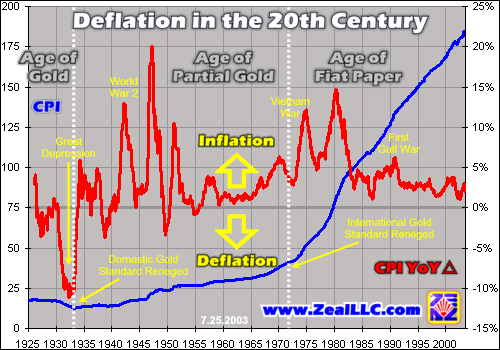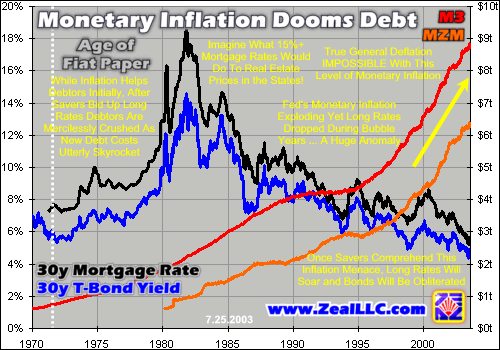Craintes de déflation : rien de nouveau...
A l'époque Adam Hamilton mentionnait déjà le débat inflation vs deflation, et il fait même référence à un article encore plus vieux (décembre 2001) où il traitait du même sujet.
Comme je l'ai aussi écrit, il explique très bien qu'il n'y a pas eu de véritable déflation depuis les années 30. Or à cette époque on était sous le régime de l'étalon or, ce qui change tout.

En 2003 déjà on débattait donc déjà des risques de déflation et nous savons comment cela a fini : une expansion des crédits et une baisse des taux réels, jusqu'à aujourd'hui.
Par ailleurs l'article décrit aussi très bien et de façon presciente la crise du crédit qui était en préparation.
Voici un extrait de l'article concernant les prêts hypothécaires ("mortgages")
Mortgages, literally Old French for “Death Pledges”, are totally dependent on long rates established by the free bond markets. As you can see above, the appropriately black line for mortgage debt prices closely tracks the yields in long US Treasury Bonds. If the bond markets suspect inflation is coming and sell off, yields will soar higher and the mortgage refinancing game delaying the inevitable bust in the US economy will suddenly end. Provocatively this has already started since June!
This phenomenon is even more of a threat today since the majority of Americans refinancing their mortgages foolishly chose to fall into the deadly trap of accepting hyper-risky adjustable-rate mortgages. With mortgage rates near 45+ year lows the prudent course of action would be to lock in fixed rates at these anomalously low levels. But the greedy mortgage industry encouraged Americans to take on more crushing debt at variable rates instead. So as the bond markets sell off and long yields and hence mortgage rates soar, the majority of Americans will see huge increases in their monthly “death pledges”. There is nothing like debt to destroy prosperity and lead to poverty!

En résumé, voici ce qu'il écrit :
Lorsqu'on se rappelle que tout ceci a été écrit en 2003, à une époque où l'once d'or était aux alentours de 350$, on ne peut nier que l'analyse s'est avérée correcte.As I mentioned in my original essay on this topic, anything typically financed by debt is likely to see its prices plunge dramatically, like houses and cars, as the ongoing Great Bear bust continues to destroy the gross excesses of debt via higher long rates. Conversely, anything not typically “paid for” with debt including groceries and general living expenses is almost certain to rise in the coming years. We are staring down a brutal environment of widespread inflation marked by various sectors witnessing falling prices as debt leverage implodes.
While general deflation was possible in the early 1930s with a Gold Standard severely limiting monetary growth, it is all but impossible now in the Age of Fiat Paper when central bankers can print unlimited amounts of inherently worthless fiat currency which inevitably leads to steep rises in general price levels.
So what’s an investor to do?
Inflationary environments marked by rising long rates decimate bond portfolios and lead to horrible bear markets in equities. The US stock markets essentially traded sideways to lower for a decade in the 1970s until the early 1980s, the very inflationary time marked in the graphs above. Inflationary price rises spawned by fiat monetary excess are bad for all intangible paper assets, not a good omen for stocks or bonds.
The ultimate financial asset to own in times of excessive monetary growth and hence widespread inflation is gold. Both the Ancient Metal of Kings itself and stocks of quality unhedged gold-mining companies thrive in such ugly environments for the general stock and bond markets. We have already been blessed with 30%+ actual annual realized equity returns in recent years in the exciting gold-stock arena, the ultimate inflation hedge. And we ain’t seen nothin’ yet!
De nouveau, je pense que ces craintes de déflation ne sont là que pour justifier de nouveaux efforts inflationnistes des autorité, jusqu'à de nouveaux excès qui se reflèteront inévitablement dans les cours de l'or.
